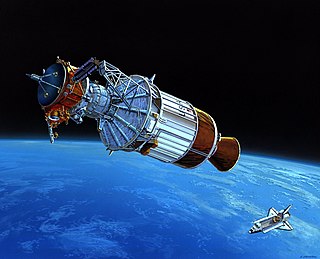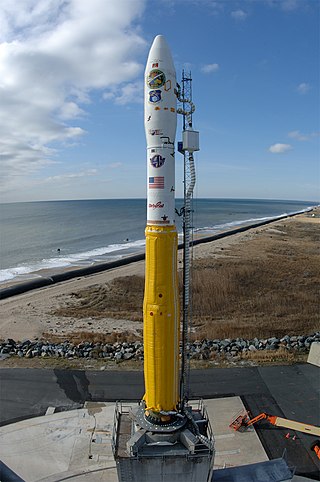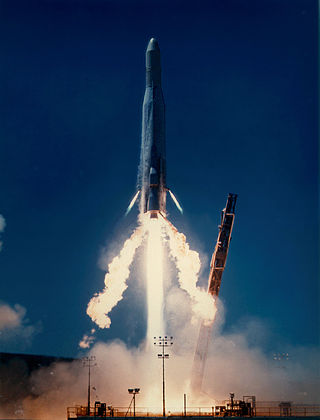| Function | Expendable launch system |
|---|---|
| Manufacturer |
|
| Size | |
| Height | 34.49 m (113.2 ft) [1] |
| Diameter | 2.34 metres (7 ft 8 in) |
| Stages | 5 or 6 |
| Capacity | |
| Payload to 200 km 28.5° LEO | |
| Mass | VI: 3,144 kg (6,931 lb) [1] VI+: 3,360 kg (7,410 lb) |
| Payload to GTO | |
| Mass | VI+: 866 kilograms (1,909 lb) |
| Payload to TLI | |
| Mass | VI+: 560 kilograms (1,230 lb) |
| Payload to Mars | |
| Mass | VI+: 300 kilograms (660 lb) [1] |
| Associated rockets | |
| Family | Minotaur |
| Comparable | Delta II,Long March 2D |
| Launch history | |
| Status | Proposed |
| Launch sites | PSCA,LP-1 CCSFS,SLC-46 |
| Total launches | 0 |
| First stage –SR-118 | |
| Powered by | 1 Solid |
| Maximum thrust | 2,224 kilonewtons (500,000 lbf) [1] |
| Specific impulse | 229 s (2.25 km/s) (sea level) [2] |
| Burn time | 56.6 seconds |
| Propellant | HTPB |
| Second stage –SR-118 | |
| Powered by | 1 Solid |
| Maximum thrust | 2,224 kilonewtons (500,000 lbf) |
| Specific impulse | 229 s (2.25 km/s) (sea level) |
| Burn time | 56.6 seconds |
| Propellant | HTPB |
| Third stage –SR-119 | |
| Powered by | 1 Solid |
| Maximum thrust | 1,223 kilonewtons (275,000 lbf) [1] |
| Specific impulse | 308 s (3.02 km/s) [2] |
| Burn time | 61 seconds |
| Propellant | HTPB |
| Fourth stage –SR-120 | |
| Powered by | 1 Solid |
| Maximum thrust | 289 kilonewtons (65,000 lbf) [1] |
| Specific impulse | 300 s (2.9 km/s) [2] |
| Burn time | 72 seconds |
| Propellant | NEPE |
| Fifth stage –Star 48BV | |
| Powered by | 1 Solid |
| Maximum thrust | 68.6 kilonewtons (15,400 lbf) (average) |
| Specific impulse | 288 s (2.82 km/s) |
| Burn time | 84.1 seconds |
| Propellant | HTPB |
| Sixth stage (Minotaur VI+) –Star 37FM | |
| Powered by | 1 Solid |
| Maximum thrust | 47.26 kilonewtons (10,620 lbf) (average) |
| Specific impulse | 289.8 s (2.842 km/s) |
| Burn time | 63 seconds |
| Propellant | HTPB |
Minotaur VI is a proposed expendable launch system derived from the LGM-118 Peacekeeper ICBM. It is a member of the Minotaur rocket family and a higher-performance derivative of the Minotaur IV. The base Minotaur VI consists of a Minotaur IV+ rocket with an additional SR118 first stage motor for improved performance. Minotaur VI is optimized for low Earth orbit (LEO) missions,and can send 3,144 kilograms (6,931 lb) to such an orbit. The Minotaur VI+ variant,however,features a Star 37FM sixth stage and is primarily intended for higher-energy missions.
The Minotaur VI and VI+ rockets are capable of launching from LP-1 at the Pacific Spaceport Complex –Alaska as well as SLC-46 at Cape Canaveral Space Force Station. Other Minotaur launch complexes,including Vandenberg Space Launch Complex 8 and MARS LP-0B,are unable to launch the vehicle without modifications because of limited integration tower height.
As of May 2024,no Minotaur VI launches have been performed and none are currently scheduled.
Minotaur VI was developed by Orbital Sciences (now owned by Northrop Grumman). Minotaur VI would be used for low Earth orbit and Sun-synchronous orbit missions. Minotaur VI+ is also available for high-energy trajectories such as geostationary transfer orbit or trans-lunar injection thanks to an additional sixth stage motor.
The Minotaur IV family (which includes Minotaur VI) is derived from the LGM-118 Peacekeeper intercontinental ballistic missile (ICBM),deployed from 1985 until 2005. The Minotaur VI utilizes decommissioned Peacekeeper solid rocket motors,which compose the first three stages in all Minotaur IV rockets and derivatives. This relatively simple architecture allows Minotaur to be launched from essentially anywhere in the US through the use of mobile launch facilities - although this capability has never been needed. [1] Because of its use of decommissioned ICBM components,Minotaur VI can only be used to launch US government missions. [3]
Two payload fairing options are available for Minotaur VI. The standard fairing,which has so far flown on every Minotaur IV and V rocket,has a 92 inches (2,300 mm) diameter and is composed of graphite epoxy sheets with an aluminum honeycomb core. The fairing features one payload access door,although more can be added if requested by a customer. The 92-inch fairing was originally developed for the Taurus rocket. A second fairing option with a 110 inches (2,800 mm) diameter is offered for larger payloads. [1]
On the Minotaur VI+,the Star 37 sixth stage is contained within the fairing.
The standard Minotaur VI rocket is composed of five stages. The first and second stage SR118 motors provide 2,224 kilonewtons (500,000 lbf) of thrust during their back-to-back 56.6-second burns,followed by stage separation and third-stage ignition. The third stage,powered by an SR119 motor,burns for 61 seconds and provides an average thrust of 1,223 kilonewtons (275,000 lbf). The fourth stage then burns for 72 seconds,with an average thrust of 289 kilonewtons (65,000 lbf). The initial four stages all have thrust vector control,allowing them to steer the rocket downrange by gimballing the motor nozzles. The third and fourth stages also feature extendable nozzles,allowing for improved performance in the upper portions of Earth's atmosphere as well as the vacuum of space. [1] [4]
The Star 48BV fifth stage burns for 85.2 seconds with an average thrust of 68.63 kilonewtons (15,430 lbf) and also features thrust vectoring,which is uncommon for Star 48 motors. [1] The Star 48 motor has also seen use on the Atlas V,Delta IV,and Space Shuttle,alongside over 70 missions on the Delta II.
Minotaur VI is primarily intended for low Earth orbit missions,with a rated capacity of 3,144 kilograms (6,931 lb) to LEO and 2,400 kilograms (5,300 lb) to SSO. [1]
The Minotaur VI+ builds off the standard Minotaur VI by incorporating a Star 37FM sixth stage. This allows the VI+ variant to either send additional payload to LEO (up to 3,360 kilograms (7,410 lb)) or send smaller payloads onto higher-energy trajectories. The Star 37FM can fly either in a spin-stabilized configuration or in a three-axis controlled variant,although some performance is sacrificed on the latter configuration. [1]
Minotaur VI+ can send up to 866 kilograms (1,909 lb) to geostationary transfer orbit,560 kilograms (1,230 lb) to trans-lunar injection,and 300 kilograms (660 lb) to a trans-Mars injection.

A solid-propellant rocket or solid rocket is a rocket with a rocket engine that uses solid propellants (fuel/oxidizer). The earliest rockets were solid-fuel rockets powered by gunpowder; The inception of gunpowder rockets in warfare can be credited to ancient Chinese, and in the 13th century, the Mongols played a pivotal role in facilitating their westward adoption.

The Polar Satellite Launch Vehicle (PSLV) is an expendable medium-lift launch vehicle designed and operated by the Indian Space Research Organisation (ISRO). It was developed to allow India to launch its Indian Remote Sensing (IRS) satellites into Sun-synchronous orbits, a service that was, until the advent of the PSLV in 1993, only commercially available from Russia. PSLV can also launch small size satellites into Geostationary Transfer Orbit (GTO).

Delta II was an expendable launch system, originally designed and built by McDonnell Douglas, and sometimes known as the Thorad Delta 1. Delta II was part of the Delta rocket family, derived directly from the Delta 3000, and entered service in 1989. There were two main variants, the Delta 6000 and Delta 7000, with the latter also having "Light" and "Heavy" subvariants. During its career, Delta II flew several notable payloads, including 24 Global Positioning System (GPS) Block II satellites, several dozen NASA payloads, and 60 Iridium communication satellites. The rocket flew its final mission, ICESat-2, on 15 September 2018, earning the launch vehicle a streak of 100 successful missions in a row, with the last failure being GPS IIR-1 in 1997. In the late 1990s, Delta II was developed further into the unsuccessful Delta III, which was in turn developed into the more capable and successful Delta IV, though the latter shares little heritage with the original Thor and Delta rockets.

The Titan IIIC was an expendable launch system used by the United States Air Force from 1965 until 1982. It was the first Titan booster to feature large solid rocket motors and was planned to be used as a launcher for the Dyna-Soar, though the spaceplane was cancelled before it could fly. The majority of the launcher's payloads were DoD satellites, for military communications and early warning, though one flight (ATS-6) was performed by NASA. The Titan IIIC was launched exclusively from Cape Canaveral while its sibling, the Titan IIID, was launched only from Vandenberg AFB.
The Vanguard rocket was intended to be the first launch vehicle the United States would use to place a satellite into orbit. Instead, the Sputnik crisis caused by the surprise launch of Sputnik 1 led the U.S., after the failure of Vanguard TV-3, to quickly orbit the Explorer 1 satellite using a Juno I rocket, making Vanguard 1 the second successful U.S. orbital launch.

The Scout family of rockets were American launch vehicles designed to place small satellites into orbit around the Earth. The Scout multistage rocket was the first orbital launch vehicle to be entirely composed of solid fuel stages. It was also the only vehicle of that type until the successful launch of the Japanese Lambda 4S in 1970.

VE 231 Saphir was a French two stage sounding rocket.

Minotaur-C, formerly known as Taurus or Taurus XL, is a four stage solid fueled launch vehicle built in the United States by Orbital Sciences and launched from SLC-576E at California's Vandenberg Air Force Base. It is based on the air-launched Pegasus rocket from the same manufacturer, utilizing a "zeroth stage" in place of an airplane. The Minotaur-C is able to carry a maximum payload of around 1458 kg into a low Earth orbit (LEO).

The Minotaur is a family of United States solid fuel launch vehicles derived from converted Minuteman and Peacekeeper intercontinental ballistic missiles (ICBM). They are built by Northrop Grumman via contract with the Space Force's Space Systems Command as part of the Space Force's Rocket Systems Launch Program (RSLP) which converts retired Intercontinental Ballistic Missiles into space and test launch systems for U.S. government agencies.

The Inertial Upper Stage (IUS), originally designated the Interim Upper Stage, was a two-stage, solid-fueled space launch system developed by Boeing for the United States Air Force beginning in 1976 for raising payloads from low Earth orbit to higher orbits or interplanetary trajectories following launch aboard a Titan 34D or Titan IV rocket as its upper stage, or from the payload bay of the Space Shuttle as a space tug.

The Minotaur I, or just Minotaur is an American expendable launch system derived from the Minuteman II missile. It is used to launch small satellites for the US Government, and is a member of the Minotaur family of rockets produced by Orbital Sciences Corporation.

Antares, known during early development as Taurus II, is an expendable launch system developed by Orbital Sciences Corporation and the Pivdenne Design Bureau to launch the Cygnus spacecraft to the International Space Station as part of NASA's COTS and CRS programs. Able to launch payloads heavier than 8,000 kg (18,000 lb) into low Earth orbit, Antares is the largest rocket operated by Northrop Grumman. Antares launches from the Mid-Atlantic Regional Spaceport and made its inaugural flight on April 21, 2013. Antares 100 was retired in 2014 and series 200 was retired in 2023 due to component unavailability. As of January 2024 Antares 300 is under development.

Minotaur IV, also known as Peacekeeper SLV and OSP-2 PK is an active expendable launch system derived from the LGM-118 Peacekeeper ICBM. It is operated by Northrop Grumman Space Systems, and made its maiden flight on 22 April 2010, carrying the HTV-2a Hypersonic Test Vehicle. The first orbital launch occurred on 26 September 2010 with the SBSS satellite for the United States Air Force.

The Atlas E/F was an American expendable launch system and sounding rocket built using parts of decommissioned SM-65 Atlas missiles. It was a member of the Atlas family of rockets.
The Atlas SLV-3, or SLV-3 Atlas was an American expendable launch system derived from the SM-65 Atlas / SM-65D Atlas missile. It was a member of the Atlas family of rockets.

Minotaur V is an American expendable launch system derived from the Minotaur IV, itself a derivative of the LGM-118 Peacekeeper ICBM. It was developed by Orbital Sciences Corporation, and made its maiden flight on 7 September 2013 carrying the Lunar Atmosphere and Dust Environment Explorer spacecraft for NASA. While Minotaur V is still likely active and available to fly, no further flights are scheduled as of May 2024.
The Minotaur III, also known as OSP-2 Target Launch Vehicle, Peacekeeper TLV, or OSP-2 TLV was an American rocket concept derived from the LGM-118 Peacekeeper missile. It was a member of the Minotaur family of rockets produced by Orbital Sciences Corporation and would have been used for long-range suborbital launches with heavy payloads. The Minotaur III was to be capable of launching 3,000 kilograms (6,600 lb) of payload 5,000 kilometres (3,100 mi) downrange. This role has been taken over by the near-identical Minotaur IV Lite and the lighter-lift Minotaur II.
The Star is a family of US solid-propellant rocket motors originally developed by Thiokol and used by many space propulsion and launch vehicle stages. They are used almost exclusively as an upper stage, often as an apogee kick motor.

A small-lift launch vehicle is a rocket orbital launch vehicle that is capable of lifting 2,000 kg (4,400 lb) or less or under 5,000 kilograms (11,000 lb) of payload into low Earth orbit (LEO). The next larger category consists of medium-lift launch vehicles.

Vanguard SLV-2, also called Vanguard Satellite Launch Vehicle-2 hoped to be the second successful flight of the American Vanguard rocket following successful Vanguard 1 satellite on rocket Vanguard TV-4.